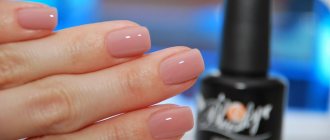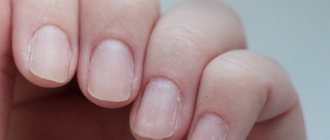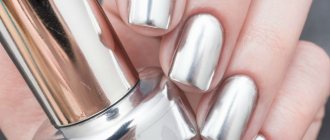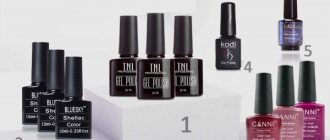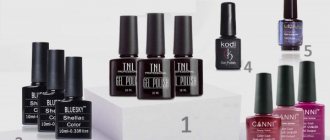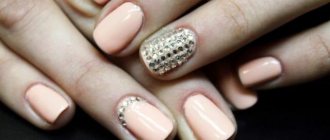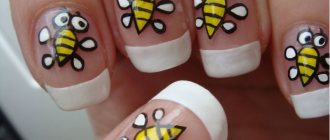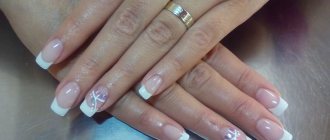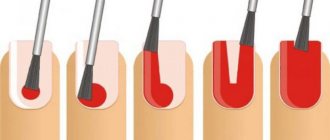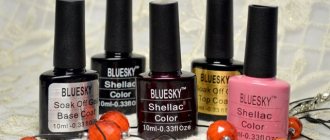Preparing nails for a manicure with gel polish: what you need to pay attention to. TOP 10 mistakes made by beginners.
Careful and high-quality nail preparation will help the master quickly and correctly apply the color coating, as well as ensure good adhesion of the nail to subsequent layers of applied materials. Unfortunately, mistakes happen at this stage in the work of both experienced craftsmen and those who have purchased kits for home application of shellac for the first time. What are the consequences of the shortcomings made when processing marigolds and applying materials for degreasing, cleansing, dehydration and improving adhesion?
- Mistake No. 1:
The gel polish base came out with sagging.
Reason:
You did not completely remove the old coating. You need to carefully file down all the layers of the previous design with a nail file or a nail file, so that the layer of the new gel polish base lays perfectly flat on the nail and evens out all the grooves and depressions.
- Error No. 2:
microbubbles and mini-voids are visible in the layer of the polymerized base.
Reason:
during the untrimmed manicure process, you did not completely remove the cuticle, pterygium and eponychium. During the baking process in the lamp, microgaps formed between the nail layer and the particles of skin remaining on the nail. When wearing such a design, detachments at the cuticle and cracks may form due to water getting under the base layer.
- Mistake #3:
The color coating peeled off the nail, starting with the base layer.
Reason:
this is due to the fact that the master could skip the stage of removing the top keratin layer with a buff. Damn the nail, it’s important not to damage it. Do not apply significant force when pressing the tool on your nails and follow the correct direction of movement. Correctly buff from the cuticle to the free edge, with light movements. The same picture is observed if a nail polisher is used instead of a buff. It will make the nail smooth instead of rough, and the coating on the nail will simply not stay on.
- Mistake No. 4:
under the layer of gel polish, cracks formed in the nail plate, which led to the nail breaking.
Reason:
cracks and chips in the nail resulted from thinning of the natural nail due to excessive sanding. The other extreme - not treating the nail well enough with a buff - can result in peeling of the coating due to the peeling keratin scales not being completely removed by the master.
- Mistake #5:
The gel polish peels off as a whole sheet.
Reason:
particles of pterygium remained unnoticed on the nail, and delaminations on the free edge were not removed. With subsequent regrowth and peeling of the pterygium from the keratin of the natural nail, the gel coating also comes off. The continued delamination of the natural nail in depth (under the gel polish) leads to detachments of the manicure already from the end.
- Mistake #6:
Shellac nails and gel polish chip a lot a few days after application.
Reason:
this phenomenon can have three reasons at once - the periungual ridges and the surface of the nail are poorly degreased with a special preparation; the primer application step was skipped; you touched the nail after degreasing and before removing the stickiness from the top coat. How to solve this problem?
- Degrease the nail step by step: disinfect your nails and hands with spray or foam. Next, remove the fat from the nails with a lint-free cloth, and finally treat the nails and side ridges with a dehydrator;
- Don't skip applying acid-free primer. It is advisable to use a product from the same manufacturer as the gel polish base. This way you guarantee maximum adhesion between the base and the natural nail;
- Try not to let your fingers touch the treated nails. If such an incident occurs, re-treat the surface with a stick remover and a lint-free puff.
- Mistake #7:
The coating cracks and breaks off in small pieces.
Reason:
you may not have sufficiently cleaned the nail from dust (sawdust), dirt and sebum (you did not properly treat the surface with a degreaser or used a substitute containing oil instead).
- Mistake #8:
Natural nails, even without blows, develop cracks right down to the flesh.
Reason:
nails suffered from overdrying. You or the technician may have used inappropriate preparations (alcohol, acetone, solvent) for cleaning and degreasing. Their regular use without subsequent treatment of nails with oil or cream leads to weakening, deep dehydration and thinning of natural nails.
- Mistake #9:
when using the base directly on a dried primer (the quality of both products is good and the expiration date has not expired), after a few days your coating still chips and peels off.
Reason:
if you have gone through and eliminated all other options, remember: do not remove the remaining degreaser from the nail with ordinary cotton pads. You can't do this. The discs leave lint that is invisible to the eye, impairing the application of coatings and leading to a loss of aesthetics of the manicure. Residual traces of oil or cream that have not been removed are also contraindicated for gel polish (they also need to be thoroughly “washed off” from the nails with a gentle degreaser). Also monitor the quality of degreasing. If you have applied the base, dried it and see bald spots, repeat the application of the base and be sure to seal the end of the nail.
- Mistake #10:
Your client has long but thin nails, the length of which you mutually decided not to remove.
Reason:
gel polish certainly shields nails from external negative influences, but cannot 100% eliminate the risk of cracks and chips. The coating maintains elasticity on the nail. And if the nail plate bends and breaks, the same will happen to the nail. Hence the deep cracks in the nail and the shellac itself. The way to eliminate the problem is to first strengthen the nails with biogel or correct the length.
Main types
Today, primers come in three varieties: pre-primer, acid-free and acidic.
Primer protects nails and preserves manicure
Pre-primer is used as a gentle protective agent for nails. The composition contains no dyes or flavors. The product has a mild effect, does not penetrate deep into the nail, does not disturb the water balance, which eliminates dryness and brittleness. However, it is not suitable as a base for extensions due to its weak adhesive ability. But the product is applied under regular varnish to preserve the original appearance of the manicure.
The acid version is not so harmless due to the methacrylic acid included in the composition. The product is indispensable for acrylic nail extensions. The primer softens the nail plate, lifting the upper scales, which allows the acrylic coating to adhere more firmly to the nail.
Experts argue about the harmfulness of the product, alternately classifying it as toxic or safe substances. With an acid primer, you need to be careful: when applying, do not touch the skin, as it will cause a chemical burn. The product is contraindicated for those with problem nails.
Svetlana Sokolova: is the primer acidic or acid-free?
The acid-free primer has a balanced composition and is suitable for working with thin and sensitive nails. It does not disturb the structure of the nail, acting on the principle of double-sided tape. Used as a base for shellac, biolacquer, gel, gel polish. But it is too “weak” for acrylic coating.
The process of creating a design with shellac and gel polish. TOP 10 common mistakes and ways to eliminate them.
If you managed to carry out the process of preparing your nails for applying shellac, avoiding all the pitfalls, do not let your guard down! Creating an image and decorating it with design also has its own subtleties and interesting life hacks.
- Mistake #1
: you carefully painted your nails with a thin layer, but after drying in the lamp you discovered polymerized streaks.
Reason:
when you or the client placed your hand in the lamp, you could keep your fingers tilted throughout the drying process. In this case, capricious or very liquid gel polishes could flow into the side rollers and onto the cuticle. You can solve this problem with the help of gel polish remover, a lint-free cloth and a metal pusher with a beveled edge. When you paint a nail, paint over the surface, avoiding the side ridges and cuticles, but also avoid gaps.
- Mistake #2
: the new gel polish chips and becomes cracked, although the design is covered with a thick topcoat.
Reason:
this phenomenon may be due to the use of an expired topcoat, a conflict of coatings (color and topcoat), or the use of a finish of poor quality.
- Error No. 3
: colored shellac was deformed after drying, bubbles and voids are visible in the coating. The gel polish has a good shelf life and was purchased from a reliable seller with a quality guarantee.
Reason:
the coating was applied in too dense layers or was not dried long enough in an LED lamp. Remember: the main rule of manicure with durable polymer coatings is to apply thin layers, squeeze the excess from the brush onto the neck of the bottle, and follow the manufacturers' recommendations on the polymerization time of materials. Another common reason is that you vigorously shook the bottle of gel polish before applying, which led to the formation of air bubbles in the thickness of the material. The correct way to lift the color pigment from the bottom is to roll the gel polish bubble between your palms.
- Mistake #4:
your manicure chips and becomes cracked, although you know for sure that the gel polish is of high quality and is stored in compliance with all rules and sanitary requirements.
Reason:
If the culprit is not shellac, turn your attention to your UV or LED lamp. If you have a completely new device, there may be a manufacturing defect. For a device that has been in use for a long time, it makes sense to check the light bulbs and replace them if the maximum service life has been exceeded.
- Mistake #5:
When applying layers, you do not brush the free edge of the nail with a brush.
Reason:
the secret to the longevity of shellac manicure is the tightness of all layers. If you neglect to seal, any of the layers of base, color, or top coat may peel off due to exposure to water, housework, or careless handling of the manicure.
- Mistake #6:
You love to create manicures by mixing colors and creating unique shades. However, despite all the tricks, the coverage lasts less than 14 days.
Reason:
Poor wear may be due to mixtures of colors from different brands, or the use of base, top, color, primer and dehydrator from different manufacturers. It’s not for nothing that brands recommend a “family” approach to purchasing materials for gel polish manicure. The fact is that the formulas of all shellac manicure products are created in such a way that their components complement each other and provide maximum durability to the design.
- Mistake #7:
Your manicure shows record wear time, but decorative elements quickly chip, become cloudy or peel off.
Reason:
the secret to high-quality fixation of decor is fixation with a second layer of topcoat, which beginners often do not do. For rhinestones, especially large ones, it will be good to coat the gaps between the crystals with topcoat. And for painting or liquid stones, it is extremely important to comply with the drying time in the lamp. A thick multi-layer design should not be dried for less than 3 minutes on the final layer of topcoat. An excellent solution for the master would be such well-proven top coatings as CND Duraforce and Tnl Viscous. Their thick, rich texture is specially designed for extra-strong fixation of decor and reliable protection of manicure.
- Mistake #8:
You use both completely new coatings and materials that have expired and are about to expire in the same design.
Reason:
It is not advisable to use old gel polishes for manicures. From the time the bottle is opened, the texture of the product changes; shellac can be applied in thick layers. When they dry, air pockets are formed, leading to inevitable detachments.
- Mistake #9:
You apply gel polish and shellac to nails that are too long, and clients soon complain about chips and cracks.
Reason:
practitioners advise not to apply gel polish on nails that are too short. Either increase the minimum length with gel on forms, or advise the client to come for a manicure as soon as at least a small free edge has grown. The fact is that contact of the edge of the nail with the pads of the fingers is fraught with the transfer of subcutaneous fat, traces of household chemicals and sweat from them. If the nails themselves do not wear shellac well, such contact with sweat and fat secretions will inevitably lead to detachments.
- Mistake #10:
Your client has little time for design, and you are in a hurry to create a finished image without observing the required number of layers, their drying time and the density of the materials applied.
Reason:
a hastily created image will not please you with longevity. The nails should be painted slowly and carefully, lightly coating the ends on each layer. If you are working with a UV lamp, dry the layers for at least two minutes each. For greater durability (especially with problem nails), the base and color should be applied in two layers each, and for voluminous and textured decor, re-coat the manicure and top coat.
Sequence of manicure
To understand whether top or base is applied first, it is recommended to study the stages of manicure or pedicure. First you need to treat your hands: remove the cuticle (using a device, tweezers, a special solvent) and shape the plates. Only after this can you begin coating, the sequence of which is as follows:
- Base coat. The base necessary to protect the nail from pigment and better adhesion of materials. With its help it is possible to level, build and strengthen the nail plate. It comes in different hardnesses, the base layer is applied in 1 layer.
- Colored varnish. Everything is clear here - this is a pigmented gel that gives the nails the desired shade. This also includes design in the form of a pattern, stamping, rhinestones, and foil. It is worth considering that it is advisable to do some of them on top.
- Finish (or top). The main function is to protect the color layer from environmental influences. It also provides a glossy shine and perfect highlight. The manicure looks like new for several weeks.
This sequence of actions is standard and should never be neglected. Of course, between important stages, the nails are degreased and dried in a lamp after using any gel, no matter it’s top or base. If you skip any step, you can forget about a perfect, long-lasting manicure. The first chips will appear in one or two days, and the work will have to be removed.
Not knowing whether the first top or base is coming, many beginners consider them interchangeable. Under no circumstances should you do this - replacing the coatings with each other will not work. These are two completely different means that carry specific functions.
Choosing a base and finish
The right choice of materials is one of the main secrets of a durable coating that will delight you for more than a week. Ideally, products from the same brand are selected. They fit together perfectly and do not conflict, but there are brands that suit many pigment coatings. If you need to save money, it is better to do it with colored gel polish - you need to buy the base and top of the highest quality. After all, they provide protection, durability and shine.
Be sure to study the composition and reviews; additional properties will only be a plus. Modern compositions often care for nails and treat them. Choose your products carefully: for example, brittle and thinning nails require a thicker, denser base. Do not miss such a nuance as comfort: if the reviews write that the brush is uncomfortable and difficult to work with the texture, then it is better to choose another option. It will not be easy to deal with such materials on your own.
Source
Top coating
It is often called a fixer, a finish. Among a good half of women who do their own manicures, there is a widespread belief that top coat is useless and is not worth spending money on. This is usually the opinion of those who do not know how the fixative works and how the nails are transformed after its application. Just don’t confuse the top coat with a simple colorless varnish. Any knowledgeable person will instantly determine what kind of manicure you have - simple, where no topcoat was used, or complete, real nail art. The fixer is no less important than the base. A logical question: why is it so needed and is it possible to do without it?
1
. The top prevents chipping and fading (sun rays are quite aggressive towards varnish).
2
. Drying time is reduced by at least half.
3
. The matte finish has a velvety effect.
4
. The previously applied layers are bonded, which affects the durability of the manicure.
5
. A glowing effect appears under certain lighting (this is noticeable when visiting clubs).
6.
A shine (“wet” varnish) appears.
7
. French manicure does not turn yellow, which is impossible without a top coat.
8
. Decorative varnish is protected from exposure to water, detergents, and mechanical stress.
Sealants are quick to apply because they dry fairly quickly.
Primer, bonder, bond - what's the difference?
When choosing a primer, you need to keep in mind that different brands have different names. For example, Nail Club calls it Bond Primer, and InGarden calls it Bonder.
Acid-free primer Bond Primer Nail Club 18 ml
Bonder Bonder InGarden 11 ml
Why did it happen so? Due to the changes that occurred with the primer as the nail industry developed. At the very beginning, manufacturers introduced a gel product to prepare the nail plate for applying a base. This primer had a dense texture and required drying in a lamp. After a while, the product was made liquid so that it would not add extra thickness to the artificial turf, and it was called “bond.” But many manufacturers retained the previous name - “primer”. Therefore, now you can find primer, bond, bonder, as well as soft bond and ultra-bond in stores.
It so happens that manufacturers produce the same product under different names. Of course, this causes confusion and complicates the choice. The easiest way to avoid making mistakes when purchasing this product is to carefully study the label. If the bonder or primer says “acid-free” or “no acid”, this is the same “double-sided tape” that will improve the adhesion between the nail and the artificial turf.
